On daily basis our body is exposed to different kinds of bacteria, viruses, etc. but ever wondered why we still stay healthy even after being exposed these deadly viruses ? It’s because of your amazing body which has the ability to resist these bacterial bodies. Now you might be wondering how exactly is this done or what is the system which is used to resist these foreign bodies ?
It’s simple our immune system is the one which protects us from various infectious agents almost everyday. Let’s start with learning human diseases and then let’s understand the concept of immunity.
Diseases:
When you hear the word diseases what strikes to your mind ? Cold, fever and sometimes diseases like malaria and dengue. Well you are somewhere right but what is the exact definition of disease ?
Disease is infection which invades our body’s normal functioning and basically damages one or more organ(s) of our body. Diseases can be of 2 types
infectious and
non-infectious. Let’s learn about these two before heading further.
Infectious and non-infectious diseases:
- Infectious diseases – Diseases which are spread by biological agents rather than other modes which are genetically, physically or chemically are called infectious diseases. These diseases are transmitted form one person to another like AIDS. These kinds of diseases are caused by fungi, bacteria, viruses, etc.
- Non-infectious diseases – The diseases which are caused by pathogens are called non-infectious diseases. These are also known as non-communicable diseases or chronic diseases. They are called chronic diseases because these diseases last for a longer period of time. Sometimes they are acute as well but chances are pretty low. Most common example of non-infectious diseases is Cancer.
Common diseases in human:
Now that we know what are infectious and non-infectious diseases are and it will be easy for us to understand further and maybe you will be able to identify which of these are infectious and non-infectious diseases (take it as an assignment).
1. Typhoid:
This disease is caused by the pathogen
Salmonella Typhi. This is transmitted through
food and
water which has been contaminated by this pathogen. The symptoms are
high fever,
weakness,
stomach ache,
constipation,
headache and
loss of appetite. These are just the basic symptoms but sometime these can go to a whole another level like
intestinal perforation (hole in the wall of gastrointestinal tract) or even
death in some cases.
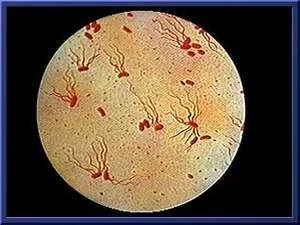 |
| Typoid bacteria under compound microscope |
Typhoid is diagnosed by the Widal Test. This pathogen starts off by infecting blood first and as blood circulates to all the parts of your body, this pathogen uses blood to infect other organs of your body too. Other names for typhoid are gastric fever, abdominal typhus, infantile intermittent fever, enteric fever, nervous fever and pathogenic fever. The fever can go high as to 40℃ (104℉). This goes from low to as high as possible.
2. Pneumonia:
Pneumonia is caused by the bacteria Streptococcus Pneumoniae and Haemophilus Influenzae. This infects the alveoli of the lungs which are the air sacs of the lungs, this causes major problems in breathing (respiration). The symptoms include fever, chills, cough and headache. In rare cases the lips and the finger nails turn gray to bluish in colour.
This disease is usually caused by inhaling the droplets released by the infected person or sharing the same things like utensils, towels, etc. with an infected person. It can occur in any age group.
3. Common Cold:
Rhinovirus is the main infectious agent known for common cold in humans. It infects the
nose and
respiratory passage (the passage from where the process of breathing takes place) which results in
nasal congestion and
discharge also known as
stuffy nose. Apart from this you end up having
sore throat,
change in the voice,
cough,
headache,
tiredness, etc. This lasts upto 3-7 days. Again this can be caused by inhaling the droplets form the infected person or sharing the same things like utensils, towels, etc.
 |
| Structure of rhinovirus |
How to prevent common cold ?
The prevention is pretty basic and you can prevent this by staying away form people who have common cold and stay at a distance from where they are resting, washing hands with soap and water after you came in contact with that infected person.
4. Malaria:
Malaria is caused by a protozoan you all must be aware of which is Plasmodium. The plasmodium group has four species which are P. Falciparum, P. Vivax, P. Ovale and P. Malariae. Many severe diseases are caused by P. Falciparum. Malaria is usually caused by P. Vivax, P. Ovale and P. Malariae. The symptoms include fever and headache. It infects the blood cells. In some cases malaria also leads to death.
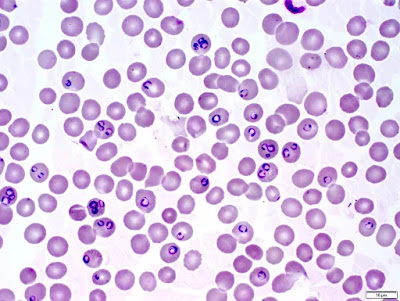 |
| Plasmodium under compound microscope |
How to prevent Malaria ?
As this is a mosquito borne disease this can be prevented by reducing the mosquito bites by the use of insect nets and repellents. Also you can use insecticides and making sure the water is not still where it is easier for the mosquitoes to lay their eggs.
5. Amoebiasis:
A protozoan
Entamoeba Histolytica is responsible for amoebiasis. This is present in the large intestine. Symptoms include
constipation,
abdominal pain,
cramps and
stools with excess mucous and blood clots. Houseflies are the one who spreads this disease. It is transmitted through indirect contact with dirty hands which have been affected by this disease, objects or anal-oral contact. The intake of this protozoan is through food or water.
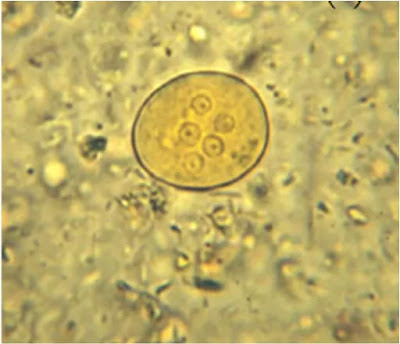 |
| Entamoeba histolytica under compound microscope |
How to prevent Amoebiasis ?
Wash your hands with soap and hot water for at least 10 seconds, pay attention to the toilet and make sure you keep it as clean as possible, avoid vegetables which use human faeces as their fertilizers, drink boiled water and a proper disposal of the waste is necessary.
6. Ascariasis:
The agent which causes acariasis is
Ascaris Lumbricoides also known as
giant ringworm. Just as the name says giant ringworm these are present in the intestine hence known as the
intestinal parasite. The symptoms include
internal bleeding,
muscular pain,
fever,
anaemia (lack of red cells or haemoglobin) and
blockage of the intestinal passage. This disease is spread through the intake of
water,
vegetables,
fruits, etc. which have been contaminated by this parasite.
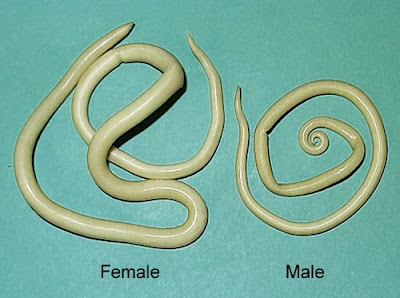 |
| Ascaris |
How to prevent ascariasis ?
As this spreads from soil it is primary to protect our food from soil and dirt, use of clean toilets, proper disposal of the waste material of your body and washing hands thoroughly.
7. Filariasis:
The filarial worm called Wuchereria bancrofti and Wuchereria Malayi are the main cause for the disease filariasis. These affect the lower lymphatic vessels of the limbs which causes it to swell and not just that but also the genital organs of that person swells as well. After swelling the leg starts to look similar to an elephant’s leg hence it is also called as elephantiasis.
 |
| Effect of filariasis |
The vectors which spread this disease are the female mosquitoes. The symptoms include edema (fluid collected in the cavities or tissues of the body) and thickening of the skin and underlying tissues.
8. Ringworm:
The fungi which belong to the genera
Microsporum,
Trichophyton and
Epidermophyton spreads this disease. Just like ascariasis this disease can also be acquired through soil or clothes or towels which was used by the infected person. Symptoms include
appearance of dry and scaly lesions on various parts of the body such as skin,
nails and scalp which causes itchiness.
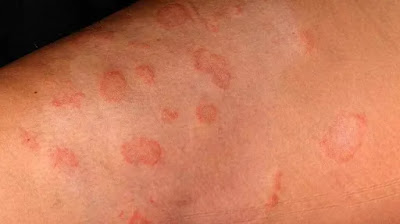 |
| Effect of ringworm |
Apart form this there are many other diseases which are common between us humans, some of them are as follows:-
- Alzheimer’s
- Chronic pain
- Diabetes
- Cancer (we will be learning about this further)
- Coronary artery disease
- Tuberculosis
- Dengue
- Hepatitis C
- Hepatitis B
Life cycle of malaria:
 |
| Life cycle of malaria |
Fatal diseases in humans:
Just like there are common diseases present between us humans sometimes these can be fatal as well and there are two which have been mentioned in your books. Just apart from these there are many other fatal and common diseases which i will also be mentioning further.
Cancer:
So we all know, cancer is a fatal disease and if not diagnosed early can lead to death, but this is just the basic. Today you will be reading about how cancer is caused, diagnosis, treatment and few more stuff. (Much more in the handwritten notes provided below).
Let’s start with understanding the term cancer. When there is an uncontrolled division of cells which form into a tumor later is called cancer. These tumors which are formed are of two types: Benign tumors and malignant tumors.
- Benign tumor – These tumors do not spread and are at a specific place and these do not invade the working of the body. If you get diagnosed with cancer in this phase it would be easy for the doctor to treat you.
- Malignant tumor – These kind of tumors spread at a very high rate and invade the functioning of the body and with the help of blood these spread to all the parts of the body and affects it. If you have been diagnosed with cancer in this phase it is going to be tough you give you treatments. As these invade the functioning of the organs these mostly affect the digestive system, nervous system and also release hormones that shorten the body functions.
Cancer multiplies at a higher rate meaning it spreads so quickly throughout the body breaking all the antibodies which are present. This is called as metastasis. There are factors like physical, chemical and biological which can cause cancer and are called carcinogens. The agents which cause cancer are called carcinogens (to know about what are the carcinogenic substances refer to the notes provided below).
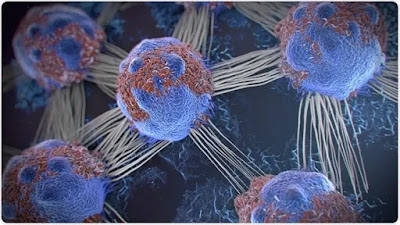 |
| Cancer cells |
Diagnosis for cancer can be carried out by the help of biopsy & histopathological studies where a tissue is removed from you body and diagnosed in the lab under microscope to understand what disease is it. Other ways for detecting cancer can be done through radiography, CT-scan and MRI. Most people suggest biopsy & histopathological studies as it is easy and affordable.
Treatment can include surgery, radiation therapy, immunotherapy, chemotherapy, hormone therapy or gene therapy. ⍺-interferon is given to the paitent which helps to activate the immune system and also acts as an antibody which destroys the tumor.
There are 5 groups which are used to classify cancer, which are as follow:-
- Carcinomas – This type of cancer is present in the parts which cover both the internal as well as the external parts of the body, eg. breast, lungs and colon cancer.
- Sarcomas – The cancer which affects the bone, cartilage, fats, connective tissues, muscles and all the other supportive tissues.
- Lymphomas – Just as the name says this type of cancer is present in the lymph nodes and also in the tissues of the immune system.
- Leukemias – This type of cancer is first present in the bone marrow and then it is collected into the blood stream.
- Adenomas – This is present in the glandular tissues such as thyroid, pituitary gland, the adrenal gland, etc.
AIDS:
AIDS stands for Acquired Immuno Deficiency Syndrome meaning this disease is acquired from out and was not an inborn disease, but in cases when the mother is an AIDS infected person she can transfer the disease to her baby via placenta. This disease is caused by Human Immuno Deficiency Virus (HIV). It affects the immune system and makes it weak and so this disease is spread easily and also the helper T-lymphocytes (TH).
We all know that HIV can be transmitted through having sex with an infected person and this is common, but there is more to this. It is not only transmitted by having sex with an infected person but also from sharing the same needles which is common in intravenous drug abusers, blood transferred from the infected person to a healthy person and from mother to the child as i told earlier.
You should know AIDS does not spread by just a touch but through body fluids like saliva, tears, semen, vaginal fluid, blood and breast milk. Symptoms include bouts of fever, diarrhoea and weight loss. The symptoms can either show up in few months or won’t show up for many years which is for 5-10 years.
AIDS is diagnosed by the ELISA test. ELISA stands for Enzyme Linked Immuno-Sorbent Assay. If the person is diagnosed with AIDS he/she is given anti-retroviral drugs. This anti-retoviral drug just helps to prolong the person’s life but cannot cure you from AIDS. Yes you can say this just acts as a antibody.
 |
| AIDS cell |
Prevention of AIDS:
As AIDS has no cure it can only be prevented. Avoid unprotected sex, use disposable needles, stay away from people who are into intravenous drug abuses because if one person of them is infected you are prone to have that disease as well and to make sure you ask the doctor before getting blood transfusion if the blood is HIV free.
NGO’s and the National AIDS Control Organisation (NACO) are putting efforts in making more and more people AIDS free by distributing free condoms and spreading awareness about what this disease is and it is not spread by just a touch.
Antigen and Antibody:
Before we head to understand what immunity is we need to understand these 2 terms which are extremely important and you should understand this.
- Antigen – A organism which is unknown to the body and can harm the body in any way or can cause disease is called antigen.
- Antibodies – The bodies which fight in response to these antigens are called antibodies.
Structure of antibodies:
The antibodies which fight these antigen (disease causing organisms) are made up of glycoproteins and these are highly specific to a specific kind of antigen. They are also known as immunoglobins. The antibodies are produced by the plasma cells and then further the B-lymphocytes form these antibodies. The plasma cell produces about 2000 antibodies per second.
 |
| Structure of antibodies |
The antibody is a “Y” shaped structure. The structure is made up of four polypeptide chains from which two are light polypeptide chains and the other two are heavy polypeptide chains that makes the structure “Y” shaped. These are held together by disulfide bonds. They are also called bivalent because the antibodies carry two antigen binding sites.
Immunity:
The body has the ability to fight disease causing organisms and this is done with the help of immunity which is a part of the immune system of our body. Immunity is divided into 2 type:
1. Innate immunity:
This is also known as natural immunity because it is present in our body at the time of birth. This is a non specific type meaning it is not specified for any antigen. Now this innate immunity has barriers in our body which doesn’t let any antigen enter in our body.
The barriers are as follows:-
- Physical barriers – These are the external type of barriers eg, skin and mucus coating of the epithelium lining the respiratory, gastrointestinal and urogenital tracts. These help in stopping the microorganisms from entering into the body.
- Physiological barriers – These barriers stops the growth the of the microbes which are trying to go into our body eg, saliva, HCL present in the stomach, tears from the eyes and rise in the body temperature in the body whilst the time of fever.
- Cellular barriers – The name says it all. The barriers are the cells of the body which fight antigens eg, leukocytes present in the WBC’s.
- Cytokine barriers – The cytokine produces proteins if it spots any cells which have been infected by a virus. It starts produces a protein called interferons in response to that antigens.
2. Acquired immunity:
This is an antigen specific immunity meaning it is given directly to fight that particular antigen. Once it has done it’s job it is stored in the form of a memory in our body so even if the same antigen encounters again with our body this immunity which had been already stored fights that antigen again.
When this antibody encounters which that antigen and responds to it for the first time it is called as primary response which is slow and has low intensity. Then when it encounters with the same antigen for the second time it is called as the secondary response and this response is very fast and has high intensity.
The lymphocytes which are present in this process are the B-lymphocytes and the T-lymphocytes. The B-lymphocytes produces an army of proteins to protect our body and the T-lymphocytes also called as the helper T-cells helps these B-lymphocytes to produce this army of proteins.
Active and passive immunity:
- Active immunity – These are already present at the time of birth in our body. The antibodies when produced for an antigen has a slow response towards it and it takes time.
- Passive immunity – These are ready-made time of immunity given when an antigen is spotted in the body.
Immune system:
The immune system is spread throughout our body so that it can kill the invaders trying to harm the functioning of our body. The immune system includes lymphoid tissues, cells and soluble molecules like antibodies (either present from the time of birth or taken for a specific antigen). The immune system also plays an important role in the allergic substances, auto-immune diseases and organ transplantation.
Lymphoid organs:
Lymphocytes are important for our body as they fight the most and where these lymphocytes originate, mature and spread at a high rate are called lymphoid organs. When the lymphocytes are in their immature phase they start to respond to that antigen and then they divide at a rapid speed and differentiate, producing more and more cells hence they are said to be antigen-sensitive lymphocytes.
Bone marrow and thymus are said to be the primary lymphoid organs.
 |
| Bone marrow |
The bone marrow is the main lymphoid organ as all blood cells and lymphocytes are produced.
 |
| Thymus present in an infant vs in an older person |
The thymus is large at the time of birth but it keeps reducing as we keep getting older.
The secondary lymphoid organs include spleen, lymph nodes, tonsils, Peyer’s patches in small intestine and appendix.
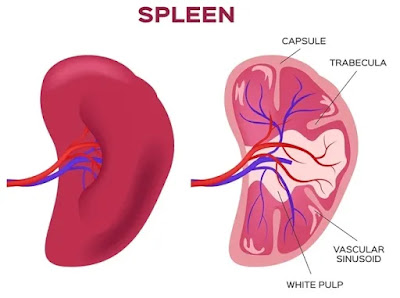 |
| Spleen |
The spleen mostly contains lymphocytes and phagocytes. It filters the blood to trap any blood borne microorganisms.
 |
| Lymph nodes throughout our body |
The lymph nodes trap the antigens which tries to get into the lymph and tissue fluids. The lymph nodes are the spread throughout our whole body.
 |
| Tonsils |
The tonsils are soft tissues and they are covered with pink mucosa.
 |
| Peyer’s patches in small intestine |
Peyer’s patched in small intestine are masses of the lymphatic tissues. They monitor the intestinal bacteria population and stops the growth of any bacteria present in the intestine.
Lymphoid tissue:
The lymphoid tissue called mucosa-associated lymphoid tissues (MALT) is present in the respiratory tract, digestive tract and urogenital tract which prevents the bacteria from entering into the body.
Handwritten notes:
Here I’m providing you with my personal handwritten notes.





















Thnku so much for this notes I'm sure that this notes will help me in revision time